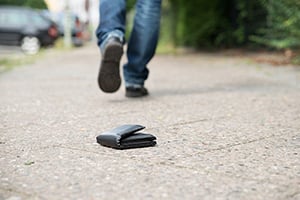Reviewed by: Melissa Rodriguez
A missing wallet can feel like a missing piece of your identity. In addition to your driver’s license or other government identification card, your wallet is home to your credit cards, debit cards, insurance cards and other important documentation. Though people lose their wallets every day, it doesn’t make it any less distressing when it happens to you. If you find yourself separated from your wallet, remember to stay calm and stick to these eight steps to protect your identity and financial information.
Most of us don’t carry much cash in our wallets anymore. That’s because we have credit and debit cards that allow us to buy items or conveniently withdraw cash when needed. In the case of a lost or stolen wallet, your credit and debit cards can quickly become a liability.

If your wallet is lost or stolen, the first thing you need to do is cancel your debit and credit cards. While you’re on the phone with the credit card issuer, let them know that your wallet was lost or stolen and request replacement cards with new account numbers.
Canceling your debit and credit cards will deter thieves from spending on those specific accounts, but with your wallet in hand, criminals may try and use your identity to open new loan accounts. To prevent anyone from borrowing money in your name, set up fraud alerts with all three credit agencies by calling one of the phone numbers listed below:
When you call any one of the credit bureaus and request a fraud alert, the alert is automatically applied to your file at all three agencies. Typically, these alerts remain active for one year unless you remove them or request an extended fraud alert.
Setting up fraud alerts with the credit agencies is one of the best ways to prevent fraud. These alerts notify the credit agencies to verify your identity before providing access to your credit report.
By now, your bank, credit card issuer and the credit bureaus should be aware of your lost or stolen wallet. While they’re on high alert for any signs of suspicious activity, you should still regularly check your own credit reports for anything out of the ordinary. Since you get one free annual credit check from each of the three credit agencies, you can spread these out over the year and check your credit report once every four months without having to pay.
Even if your credit cards aren’t missing or stolen, you should always monitor your credit by periodically checking your credit report. If you see something unfamiliar on your credit report, contact the company that made the inquiry for more information.
Missing wallets might not seem like a top priority to police, but filing a police report is crucial if your wallet is stolen or goes missing.
A police report helps authorities locate you if they recover your missing wallet, but more importantly, can protect you in case someone tries using your identity to commit fraud. Police reports can serve as evidence in identity theft cases and in disputing fraudulent charges. You might not be worried about that when your wallet first goes missing, but remember, without proper documentation from the police department, you could be on the hook for any charges fraudsters rack up in your name.
You can file a police report by calling the local police department where the incident occurred. Most police departments also offer the option of filing a report online. Regardless of how you file a police report, make sure you get a copy of the report for your records.

When your wallet goes missing, your primary concern is usually keeping your money out of someone else’s hands. Unfortunately, your bank accounts and credit cards aren’t the only targets for identity thieves.
Medical identity theft can occur when someone steals your information and uses it to buy prescription drugs or submit claims for doctor visits, prescription drugs, or other medical supplies or care. Besides the potential financial consequences of medical identity theft, this type of fraud can also damage your credit and affect your ability to get the care you need.
Calling your health insurer and getting replacement cards may not be top of mind if your wallet is lost or stolen, but it can be every bit as important as canceling your credit cards.
Since a lost or stolen wallet often means new account numbers, you’ll need to update any automatic payments you have on your financial accounts, like your credit cards, mortgage or car loan. Updating your auto-pay accounts in a timely manner will ensure you avoid paying any late fees and will help avoid accidentally missing payment deadlines.
The next step in making a quick recovery when your wallet is lost or stolen is replacing any missing identity cards, like your driver’s license or government-issued ID card. Fortunately, replacing a driver’s license or state ID card is relatively straightforward. Usually, you can do that online, by mail or by visiting your local driver license center.
Regularly carrying your social security card in your wallet is a bad idea, but sometimes, it’s difficult to avoid. For instance, if you get a new job or renew your license, you may have to present your social security card.
If you lose your Social Security card along with your wallet, you can order a replacement online through the Social Security Administration (SSA) website. However, if your wallet is stolen, you’ll have to file a report with the Federal Trade Commission (FTC) and contact the Social Security office for an appointment to get a new number.
Losing your wallet can expose your online accounts, which is why you should update passwords to any online financial accounts. Protecting your passwords helps keep your sensitive information safe, so be sure to update your old password with a new, stronger password and enable multi-factor authentication for an extra layer of security.
Identity theft can happen to anyone and at any time. With your wallet in hand, scammers can access your identity, but that’s just one way fraudsters commit identity theft. Identity thieves can also get their hands on your information by digging through your trash for old tax documents or bank statements, on the internet via social media or by creating more elaborate scams using artificial intelligence.
To avoid falling prey to identity theft, protect your identity by following these best practices:
To combat the rise in identity theft, take advantage of the numerous apps and programs that can help you protect your identity. These apps, like ID Shield, IdentityForce, LifeLock and your mobile banking apps, can help secure sensitive information and protect your data through encryption, multi-factor authentication, activity monitoring and more. You may also want to consider utilizing a digital wallet (e.g., Apple Pay or Google Pay) as a safer payment option since mobile wallets eliminate some of the risks of carrying physical credit and debit cards.
Though everyone makes mistakes and gets hit with bad luck now and again, there are several ways to minimize the odds of losing your wallet. First and foremost, staying organized can help you keep better track of your wallet. For some people, that means scaling back on the size of your wallet or even transitioning to a phone wallet case, so your wallet goes everywhere your phone goes. If you’re constantly leaving your wallet behind, you can always attach a Bluetooth wallet finder to it, though these devices tend to have a limited range.
Preventing your wallet from loss or theft is always ideal, but when your wallet disappears, your bank should be there to help you get back on your feet as quickly as possible. If you lose your wallet or are a victim of fraud, Seacoast is here to guide you through exactly what to do. Call 800-706-9991 to speak with a Seacoast customer service professional or visit any Seacoast Bank location.
Topics: Protect Your Finances, Fraud Victim, Fraud Support
Are you interested in contacting a local, Florida banker to discuss your individual financial needs? We’d love to speak with you. Schedule a consultation today.
Share: